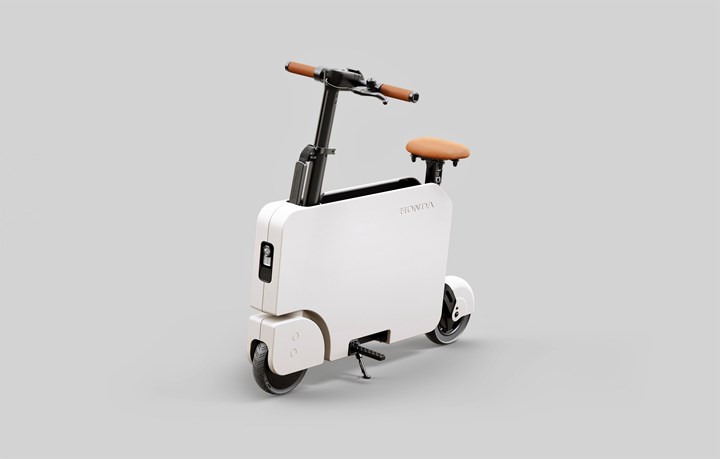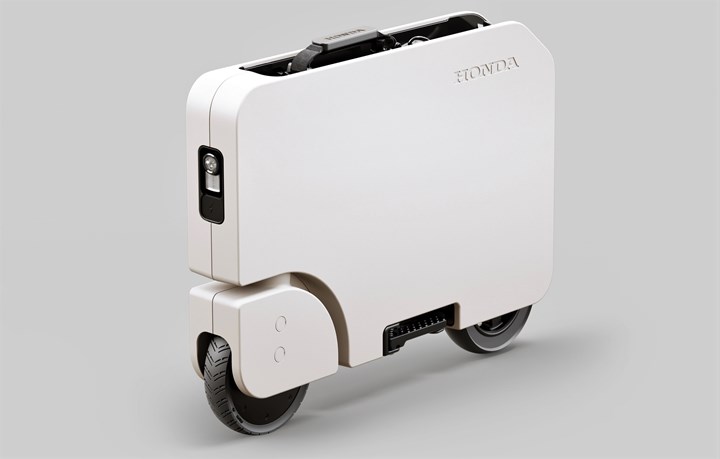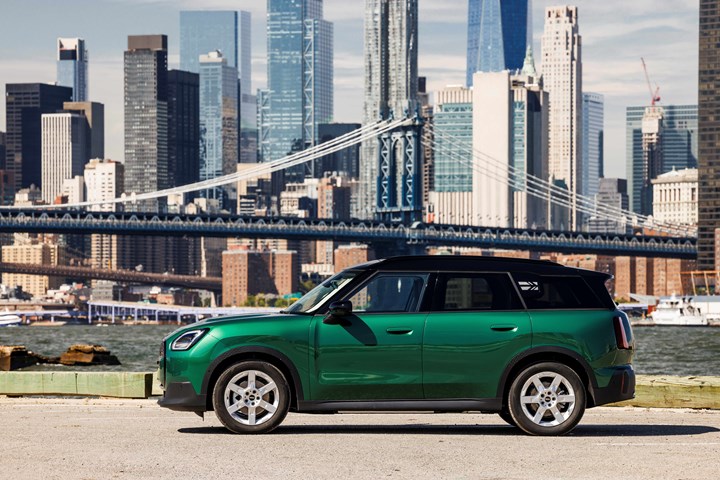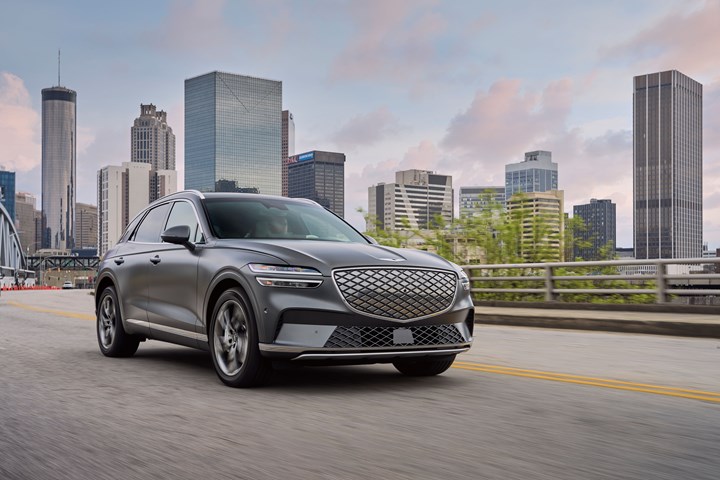on Alfa, eco-interiors, Honda scooter, Genesis EV, and more
Alfa Romeo’s approach. . .Kia’s interior concepts. . .fuel type quiz. . .Ford on manufacturing. . .suppliers at risk. . .Chinese EV demand. . .Honda’s Motocompacto. . .MINI Countryman. . .Genesis Electrified GV70. . .
#interior
Alfa Romeo and the Importance of Focus

Larry Dominique heads Alfa Romeo efforts in the U.S. He thinks EVs will be a successful path for the brand to follow. (Image: Stellantis)
Alfa Romeo, the 113-year-old producer of premium performance vehicles, made its return to the North American market after a hiatus of 13 years, in 2008.
The company’s impact on the market has been. . .marginal. Through Q3 2023 the Stellantis brand sold 7,590 vehicles in the U.S. That’s from three vehicles, the Giulia (a sedan), the Stelvio (an SUV) and the Tonale (an SUV introduced earlier this year).
(OK, it did sell the 4C sports car in 2023. One of them.)
How is the brand going to gain traction in the market?
Focus.
Focus on Quality
One of the bad reps that the company had been dealing with is quality.
Larry Dominique, senior vice president and head of Alfa Romeo North America, says they’ve been working hard to turn that around.
And it is working.
In the J.D. Power 2023 U.S. Initial Quality Study (IQS) Alfa finished at the top of the rankings for premium brands and third overall with a score of 143 problems per 100 vehicles (PP100). Notably, the next premium brand on the overall brand ranking list was Porsche—tied for sixth place (with GMC) with 167 PP100.
The focus on quality can provide potential Alfa customers with a sense of confidence.
Dominique: “If you don’t have quality or customer satisfaction, you don’t have a brand.”
(While Alfa didn’t top the 2023 J.D. Power U.S. Customer Service Index, it did have the largest year-over-year improvement of any brand.)
What It Is
Dominique says there are three characteristics that are essential to the Alfa brand:
- Italian: It was founded in Milan as A.L.F.A.: Anonima Lombarda Fabbrica Automobili. If there is one thing that stands out about the vehicles it produces is the styling, which is distinctively non-German, non-Asian and non-American.
- Sportiness: The company has been involved in motor sports since 1911, or the year after its founding. All of its consumer vehicles have a bias toward performance.
- Rosso: While that is Italian for red, Dominique emphasizes that it is more about the emotion that the brand works to convey than the color of the cars (although rosso is certainly on the palette).
Looking forward, there is something that may make a bigger difference for Alfa in the U.S. than many other brands with which it competes:
Going electric.
Plenty of premium brands have announced the electrification of their portfolio at some point in the future.
Alfa’s point is by the end of 2027.
Why This Is Different
Dominique says that today, for example, you can buy a Giulia as a Sprint, Ti, Veloce, or Competizione. All of them are fitted with a 2.0-liter four that produces 280 hp. So how, he asks, is there differentiation? Tires. Wheels. Aesthetics. Other changes. But he says that there will be the opportunity as the brand switches to electric to provide true performance differences among the trims in the lineup in a way that isn’t particularly practical with an ICE powertrain. Thanks to electric motors: “The Veloce might have 500 hp and the Sprint 300 hp,” he says.
These differences are made all the more achievable for Alfa for the simple reason that it is part of Stellantis, which includes Chrysler, Citroën, Maserati, Opel, Peugeot and other brands.
Stellantis has announced the development of four battery-electric-specific platforms (STLA Small, Medium, Large, and Frame), three electric drive modules, and two battery cell chemistries. Stellantis plans to have 100% of its European sales and 50% of its U.S. sales to be EVs by 2030.
Dominique says the platforms (Alfa is most oriented toward STLA Medium and Large) are designed such that they inherently provide variability. He also points out, “The platform is where the money is”—meaning that platforms are expensive, so being able to share them across brands means there are economies of scale and the savings achieved can allow Alfa to focus on things that are important to its DNA (e.g., “I’m willing to sacrifice a little range for performance,” he says).
So the EV platforms and drive modules will allow Alfa to precisely tune and engineer vehicles.
Which brings us back to focus.
Dominique says when Alfa makes the transition to EVs there will only be EVs. There will not be an issue of trying to convince a prospective customer about the EV version of a given model rather than the ICE version that is right next to it.
“I don’t want to think ICE or EV.”
Focus.
///
Kia’s Natural Approach

The interiors of two Kia concepts—EV3 on the top and EV4 on the bottom—which are proof points that using recycled and natural materials can be done without sacrifices in functionality or appearance. (Image: Kia)
The inside of the Kia Color, Materials, Finish (CMF) facilities probably smell more like a Whole Foods than a traditional studio.
Kia’s Concept EV3 and Concept EV4 vehicle interiors are chock full of nuts and other natural materials.
- Nuts: Walnut shells and madder (a.k.a., Rubia tinctorum) roots are used for dyes that are applied to the 100% recycled cotton material used in the Concept EV4 cabin
- Hemp: It is used to construct a console table in the Concept EV4
- Mushrooms: Not to be outdone by that hemp, the console table in the Concept EV3 is made with Mycelium, sourced from mushroom roots. Noted Marila Biill, head of CMF Design at Kia: “Using Mycelium enables us to mimic the processes we see in nature and leverage it to design more sustainable solutions—the material can be grown in any shape you want using a mold.”
The use of natural materials at Kia isn’t just conceptual.
The just-launched EV9 includes components for the dashboard, console, pillars, and trim produced with bioplastic—developed with such things as vegetable oils, corn extract, sawdust, and sugarcane.
A bio-polyurethane is available as a leather replacement.
Discussing the mushrooms, Biill said, “One day, by growing our own materials, we’ll be able to simplify processes, adapt forms and most importantly, be closer to nature in its essence.”
///
Quick Quiz: Fuel Type Edition
The percentage of vehicles in operation (VIO) by fuel type as of July 1, 2023, that are powered by gasoline engines—and we’re talking light vehicles here—is 93%, according to S&P Global Mobility.
There are three other categories:
- Diesel
- Hybrid
- Electric
Given the preponderance of gas-powered vehicles, the remainder is consequently low.
- But what are the percentages for the remainder?
- What is the order of fuel types?
As for the percentage, here’s a clue: the non-gas vehicles combined is 6.8% rather than a full 7% because there is an “other” category not included.
The answers are found once you scroll all the way down (or simply read everything between here and there).
///
Good Point, Mr. Ford

Bill Ford in front on an image of the legendary—and still operating—Ford Rouge Plant. (Image: Ford)
“A strong manufacturing base is critical to our national security. Building things in America matters now more than ever, especially in these uncertain times. We cannot take that for granted.
“In my lifetime, I have watched countries lose their auto industry, and then virtually all industries after that. Countries that once had vibrant industrial bases no longer make anything. They have become dependent on others for critical products, aspects of their supply chain, and even national defense.”-- Ford Executive Chair Bill Ford, October 16. 2023
Don’t want that to happen.
///
Sorry, Suppliers
PwC recently released its “2023 Automotive Supplier Consolidation Study,” which includes assessments of what happened in 2022, and for those who work for suppliers aren’t going to be surprised at some of the findings.
Like:
- Nearly 50% of suppliers showed increasing signs of stress compared to 2021
- 42% had “deteriorating operational performance”
- 7% were “at risk” due to financial distress in ‘22
- Powertrain and chemical suppliers were in the category of “most distressed automotive supply subsectors”
But there was a bit of brightening:
“H1 2023 was showing positive signs of improvement. . .”
Then the other shoe drops:
“. . .but several industry headwinds and macroeconomic uncertainties present a significant risk for H2 2023.”
Like the UAW strike.
No surprise to suppliers.
///
Chinese EVs for the Chinese

The BYD Dolphin. (Image: BYD)
3,606,680.
That’s the number of electric vehicles in the passenger car category sold in China during the first eight months of 2023, according to Inovev.
It represents 23% of the Chinese passenger car market.
The number in the U.S.? About 7%. According to Kelley Blue Book, during the first three quarters of 2023 there were 873,082 EVs sold in the U.S.
Of which 493,513 were from Tesla.
(Note that Tesla Shanghai, which produces the Models 3 and Y, started building vehicles in December 2019 and as of last month produced two-million vehicles, making it the most-productive EV plant on the planet.)
Twenty-six brands accounted for the other 379,569 EVs sold in the U.S.
Meanwhile, back in China, Tesla accounted for 17% of the EV sales, with Chinese OEMs having 72%--or 2,603,831 units—of the market.
Of the remaining 11% of the Chinese market that isn’t a domestic brand or Tesla, 8% are from European brands and the rest Japanese, Korean and American.
Clearly, Chinese consumers are interested in Chinese EVs.
///
Going the Last Mile in Minimalist Style

Honda designers and engineers wanted to come up with an efficient, electric means of transport that is fun and functional. The result: the Motocompacto. (Images: Honda)
According to the U.S. Bureau of Transportation Statistics, in 2022 e-scooters served 158 cities.
Odds are if you live in or have visited any one of those cities, at some point you saw—or perhaps tripped over—one of those devices, consisting primarily of handlebars on a stem that connects to the deck and wheels, that was ostensibly abandoned.
A paper published in Transportation Research Part A, “To scoot or not to scoot: Findings from a recent survey about the benefits and barriers of using E-scooter for riders and non-riders,” notes:
“Dockless electric scooters (e-scooters) are a relatively new transportation option rapidly changing travel in US cities and on university campuses. Hailed as a convenient, inexpensive solution for last mile (i.e., to/from transit) and other short trips, e-scooters are available in over 100 US cities and were used for nearly forty million trips in 2018 (NACTO, 2019; Sandt & Harmon,2019). A recent representative survey of ten cities found that e-scooters had achieved an adoption rate nearly equal to that of ridehailing i.e., much faster than past forms of shared mobility (Populus, 2018).”
That paper appeared in 2020, and the growth of e-scooter proliferation—based on the increase in cities served in just three years—is growing.
Mobility & OEMs
However, as Andrew Grant of BloombergNEF recently wrote, “In the years leading up to the pandemic, automakers were eager to cast themselves as more than just automakers. The CEOs of manufacturers including BMW, Ford and Toyota vowed to remake their enterprises into mobility companies.”
Grant goes on to note: “Some of the earliest and loudest backers of mobility services have shuttered or significantly reduced divisions managing these activities.”
While not anything near a full-blown mobility system (e.g., remember “Maven,” GM’s app-based car sharing service, which the company described as a “personal mobility brand” when announced in 2016 (shuttered in 2020)?), Honda has developed what is a personal mobility device that is in keeping with the e-scooter trend.
The Honda Approach
Called the “Motocompacto,”* the unit is an electric scooter that a rider sits on rather than stands on. (Nick Ziraldo, project lead and design engineering unit leader at Honda Development and Manufacturing of America, says that lowering the rider’s center of gravity makes it safer than a standing scooter. One thinks that a company like Honda is far more cognizant of things like safety than typical scooter producers.)
It folds into itself such that when collapsed it appears like a box measuring 29.2 x 21.1 x 3.7 inches with a handle. The “box” is the body of the unit. It is made with molded-in color ABS. It weighs 41.3 pounds so not only does that and the rectangular configuration make it portable, but it is readily storable (on a train, in an office, at home, or in a vehicle).

Providing strength and contributing to the low mass is a heat-treated aluminum frame.
The vehicle can accommodate a rider weighing up to 265 pounds.
The Motocompacto has a range of 12 miles—the Samsung 6.8-Ah lithium-ion battery can be fully charged with a standard 110-V outlet in 3.5 hours—and a top speed of 15 mph.
The scooter will be available at Honda and Acura dealers for $995.
Jane Nakagawa, vice president of the R&D Business Unit at American Honda:
“Innovation doesn’t have to be expensive or complicated.”
The teams in Ohio and California who developed the Motocompacto received 32 patents for the personal transportation device.
==
*Its design is inspired by the Japan-market Honda Motocompo foldable gas-powered scooter (1981-83) that was engineered to fit within the hatch of a subcompact.
///
MINI Countryman: Grows & Moves

Not only has the MINI Countryman grown over the years, but it has also been moved around from factory to factory during its lifetime. (Image: MINI)
In 2010 the folks at MINI recognized that the world was pretty much going BIG, so they launched the MINI Countryman, a five-door crossover that was still pretty small.
That initial offering is 161 inches long, 70.4 inches wide, 61.5 inches high, and features a 102-inch wheelbase.
Then in 2017 the second-generation Countryman launched and it was less mini than its predecessor: 169.8 inches long, 71.7 inches wide, 61 inches high (yes, ½ inch lower), and having a 105-inch wheelbase.
And last month the company introduced the third generation MINI Countryman and, yes, even bigger: 174.5 inches long, 72.5 inches wide, 65.2 inches high, and a 106-inch wheelbase. More than a foot longer than the first iteration.
But that isn’t entirely surprising. What doesn’t get bigger?
Plant to Plant to. . .
But what is somewhat atypical is the way the Countryman has had its production shifted.
The first-generation vehicle was produced by Magna Steyr in its Graz, Austria facility.
Gen-two was produced by Nedcar in the Netherlands. Nedcar is a contract manufacturer that has produced vehicles including the Mitsubishi Colt, smart Forfour, MINI Hatch and Convertible, and BMW X1.
And with this new Countryman, the production location has switched again, this time to the BMW factory in Leipzig, German, where the BMW Series 1 and Series 2 Active Tourer and Gran Coupe are also built. (As you probably know, BMW owns MINI.)
Quite a journey for the MINI Countryman.
///
2023 Genesis Electrified GV70 AWD Prestige

The Genesis Electrified GV70. Great car. Awkward name. (Does this matter? Well, say someone asked what you drive and you answer “Electrified GV70.” And the person who asked drives a hybrid, so she could use that adjective in front of the name of her car, too. Which makes your driving an EV less special.) (Image: Genesis)
According to the folks at Upwork, a platform that connects talent with companies, there is a six-step method for coming up with a “great brand name.”
They are:
- Identify your target audience
- Define your brand personality
- Make a list of brand name ideas
- Narrow your list
- Check for availability
- Test your shortlist of potential brand names
Of course, this is pretty much a DIY list.
Corporations engage branding agencies, firms that specialize in doing all of these steps (and then some).
Which leads me to wonder what happened at Genesis HQ when the product, brand and marketing personnel were presented with:
2023 Genesis Electrified GV70 AWD Prestige
OK.
There are the model year and the brand name. Check. Check.
There is the model name, GV70, for the compact crossover, which is also available with either a 2.5-liter turbocharged four-cylinder engine or a 3.5-liter twin-turbocharged V6. So again, check. Check.
Then there is the fact that it has all-wheel drive and the Prestige is the trim package. Check. Check.
But really:
“Electrified GV70”?
Sounds clunky.
(Genesis also offers the Electrified G80, a sedan.)
Of the items on the naming list I wonder about whether 1, 2 and 6 were really entertained.
The quibble about the name is because, this EV, which is being manufactured at a plant in Montgomery, Alabama, may be overlooked by those who are looking for a fully electric crossover, might think to themselves, “’Electrified’ tends to be used to describe hybrids, not EVs,” and consequently leave the vehicle out of consideration, which would be their loss.
- First, the vehicle has the superb Genesis design language that is confident, not trying too hard, as is the case with some OEM offerings.
- Second, there is surprising performance with 160-kW motors fore and aft that provide a combined 429 hp—and should you engage the “Boost Mode” button, for 10 seconds that goes up to 483 hp.
- Third, there is a comfortable leather-clad interior with such things as a 14-way power driver’s seat and 12-way for the passenger, both heated and ventilated, and heated seats for those sitting in the back. There are a 12.3-inch digital instrument cluster and a 14.5-inch HD infotainment screen. It is a nice place to be.
- Fourth, there is an array of standard tech including Lane Keeping Assist, Lane Following Assist, Blind-Spot Collision Avoidance-Assist, Blind-Spot View Monitor, Rear Cross-Traffic Collision Avoidance-Assist, Highway Driving Assist, Smart Cruise Control with Stop & Go, Intelligent Speed Limit Assist, Driver Attention Warning, High Beam Assist, Surround View Monitor, Parking Distance Warning, Parking Collision-Avoidance Assist – Reverse, Remote Smart Parking Assist, Safe Exit Assist. . . .
Of course, anyone who is interested in getting an electric vehicle is concerned first and foremost, it seems, with range. This vehicle gets an estimated 236 miles from its 77.4-kWh lithium-polymer battery. Which is so-so.
However, a DC fast charger (800 V) can bring the battery charge from 10% to 80% in 18 minutes, so that means ~189 miles. (Here’s something of interest: the vehicle comes with three years of complementary DC fast charging at Electrify America stations, so there are plenty of those 80%+ charges on tap for free.)
Oh, and it is under $70K.
You can find less expensive two-row crossovers. But you’d be hard-pressed to find a nicer one.
If only there wasn’t that name. . . .
///
Quiz Answers
The vehicles in operation that aren’t powered by gasoline by percentage:
- Diesel: 3.2%
- Hybrid: 2.6%
- Electric: 1.0%
Who would have thought there are that many light-duty diesels still out there?
And given all of the attention paid to EVs. . .1%?
A couple points about the number of electric vehicles, per Tom Libby, S&P Global Mobility’s associate director of Loyalty Solutions & Industry Analysis:
- There are 2,682,153 EVs out there (as of July)
- Some 25% of EV owners. . .get a gasoline-powered vehicle
RELATED CONTENT
-
On the Genesis GV80, Acura MDX, BMW iDrive and more
From Genesis to Lamborghini, from Bosch to Acura: new automotive developments.
-
On Traffic Jams, Vehicle Size, Building EVs and more
From building electric vehicles—and training to do so—to considering traffic and its implication on drivers and vehicle size—there are plenty of considerations for people and their utilization of technology in the industry.
-
Choosing the Right Fasteners for Automotive
PennEngineering makes hundreds of different fasteners for the automotive industry with standard and custom products as well as automated assembly solutions. Discover how they’re used and how to select the right one. (Sponsored Content)


.jpg;width=70;height=70;mode=crop)






